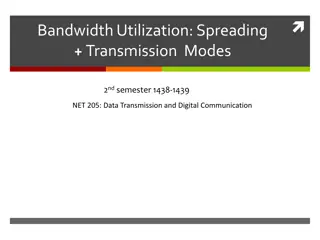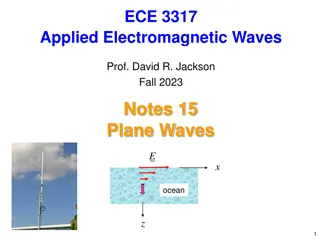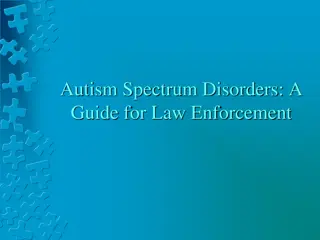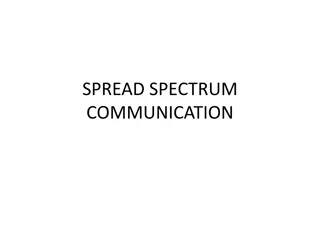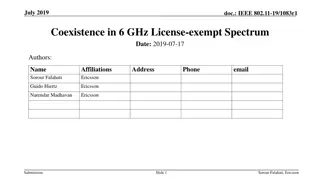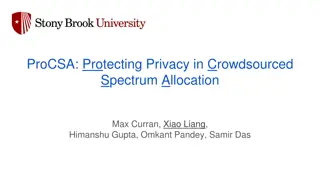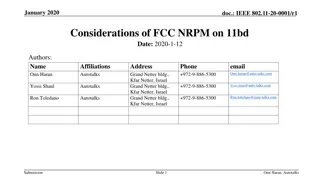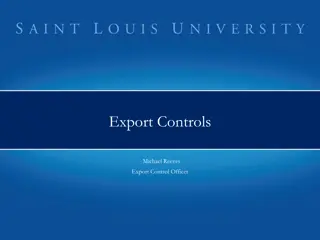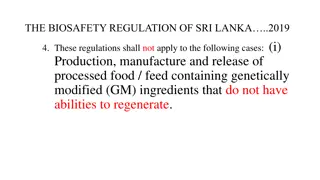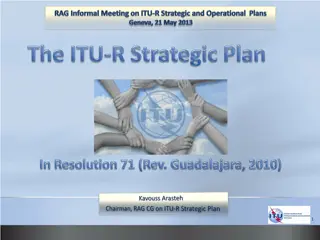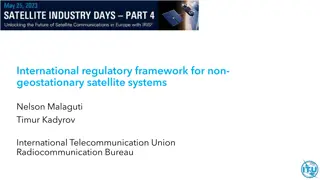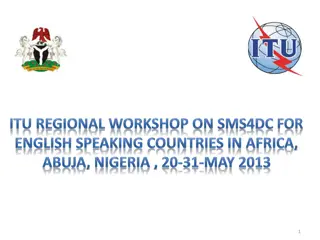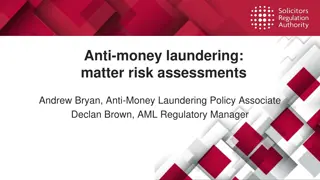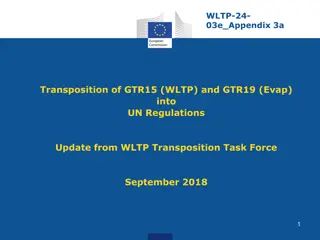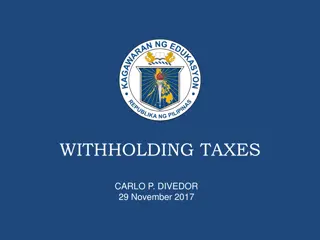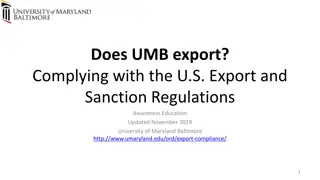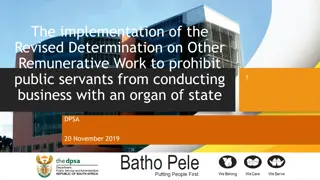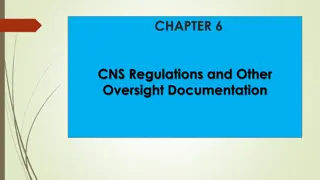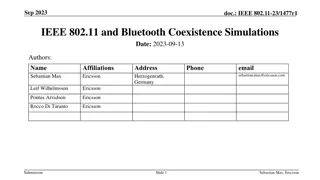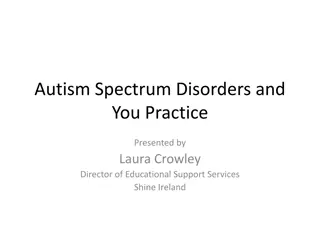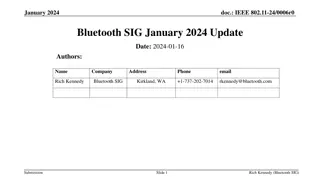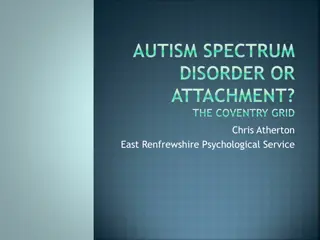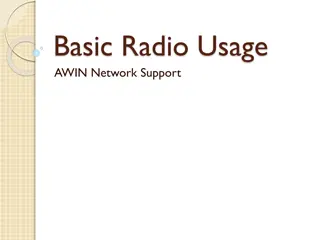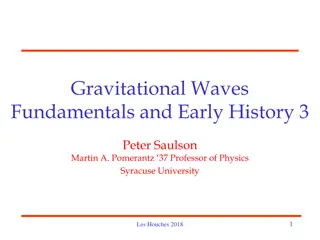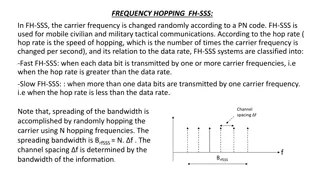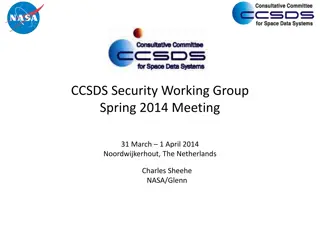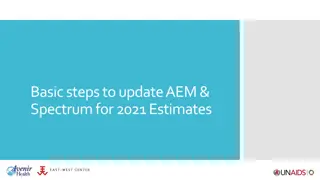Introduction to Spectrum Management and Regulations
Spectrum management involves administrative and technical procedures to ensure efficient radio-frequency spectrum utilization without interference. It includes allocation, allotment, and assignment of frequencies for various radiocommunication services. Specific terms related to frequency management and radiocommunication services are defined in the ITU Radio Regulations. The Regulations outline the use of frequency block allocations for defined radio services.
Download Presentation

Please find below an Image/Link to download the presentation.
The content on the website is provided AS IS for your information and personal use only. It may not be sold, licensed, or shared on other websites without obtaining consent from the author. Download presentation by click this link. If you encounter any issues during the download, it is possible that the publisher has removed the file from their server.
E N D
Presentation Transcript
DAY 3 Enforcement and Compliance Spectrum Management AFRALTI 1
Spectrum Management Introduction Justification of Spectrum Management Spectrum as a Resource Need for Spectrum Regulations Tools for Enforcement Spectrum Coordination Spectrum monitoring and Compliance Spectrum Fees AFRALTI 2
Definition of spectrum management (as per ITU Study Group 1 ): Spectrum management is the combination of administrative and technical procedures necessary to ensure the efficient utilization of the radio-frequency spectrum by all radiocommunication services defined in the ITU Radio Regulations and the operation of radio systems, without causing harmful interference. AFRALTI 3
Specific Terms Related to Frequency Management (RR 1) Allocation (of a frequency band): Entry in the Table of Frequency Allocations of a given frequency band for the purpose of its use by one or more terrestrial or space radiocommunication services or the radio astronomy service under specified conditions. Allotment (of a radio frequency or radio frequency channel): Entry of a designated frequency channel in an agreed plan, adopted by a competent conference, for use by one or more administrations for a terrestrial or space radiocommunication service in one or more identified countries or geographical areas and under specified conditions. Assignment (of a radio frequency or radio frequency channel): Authorization given by an administration for a radio station to use a radio frequency or radio frequency channel under specified conditions. AFRALTI 4
Specific Terms Related to Frequency Management (RR 1) Radiocommunication service: A service involving the transmission, emission and/or reception of radio waves for specific telecommunication purposes (RR 1). Radiocommunication is sub-divided into space and terrestrial radiocommunication: Space radiocommunication is defined in Article 1 of the Radio Regulations as any radiocommunication involving the use of one or more space stations or the use of one or more reflecting satellites or other objects in space . Terrestrial radiocommunication is defined as any radiocommunication other than space radiocommunication or radio astronomy . Definitions for more than 40 radio services are provided (ITU RR, AC National Table of Frequecy Allocation, 2017, ed 2016). AFRALTI 5
Radio Regulations The RR is the principal instrument of the international radio regulatory arrangement It is based on the use of two main concepts: Frequency block allocations intended for use by defined radio services = Table of Frequency Allocations as contained in RR Article 5 (from 9 kHz to 1 000 GHz) generally provides common frequency allocations to mutually compatible services operating with similar technical characteristics in specific parts of the spectrum is a stable planning environment for administrations, for equipment manufacturers and for users Voluntary or obligatory regulatory procedures (for coordination, notification and recording of assignments) adapted to the allocation structure and vary from service to service Objective to obtain international recognition of recorded frequency assignments (RR Article 8) AFRALTI 6
Spectrum Requirements It takes 4 years for spectrum to be allocated and identified at ITU level The allotment then assigned at national level until it is finally deployed in the network. Planning and Assignment of the spectrum is done at ITU WRC every 4 year Spectrum Requirements-Main Drivers: As mobile traffic increase price decrease, internet connection, convergence to other industries, tablets& smart phones, new mobile applications AFRALTI 7
Justification for Enforcement Spectrum as a Resource Spectrum Requirements Spectrum as a Technical Resource Spectrum Scarcity of Spectrum AFRALTI 8
CA Mandate In accordance with the Kenyan Legislations, all radio communication equipment in Kenya must be owned and/or operated under a license, issued by CA and which must be kept in force at all times by regular payment of the prescribed license fee. This legislation is contained in the Kenya Communications Act 1998, Section 35 to Section 46. This is Act is complemented by the Kenya Communications Regulations, 2001 and 2009 (amendment) and other subsidiary legislations as Government Legal notices / Sector Policy statements that may be issued by the Minister in charge of communications from time to time. The Authority plans frequencies for use by various services every four years following results from the WRC National Table of Radio Frequency Allocations 2016 Edition is available at the Website of the Authority. AFRALTI 9
The Services that Require Frequency Licence The services that require frequency licenses from CA include; TV and FM radio broadcasting; cellular mobile telecommunications, satellite communications; aeronautical and maritime radio services and; emergency and disaster communication services. CA carries out inspection and monitoring exercises. to ensure that assigned spectrum is used in accordance with the license terms and conditions, CA provides Guidelines for use of Wireless Access Systems (WAS) on Shared Non Protected Basis in the 2.4GHz and 5GHz Frequency Bands AFRALTI 10
CA Mandate CA is responsible for management of the country s radio frequency spectrum resources. Management of spectrum resource entails planning and assignment of spectrum to various radio communications services and users. CA carries out national co-ordination to ensure harmonious sharing of frequencies by various users and services. CA performs international and regional frequency co- ordination to avoid harmful interference of frequency users in different administrations. AFRALTI 11
Objectives of Spectrum Management Spectrum management reflects many separate activities, including : Planning spectrum use, Allocating and Assigning spectrum licences, Enforcing licence conditions, Interacting with a regional and international organisations etc. on assignments, etc. AFRALTI 12
Objectives of Spectrum Managements Each of the objectives will have its own key performance indicators.: An enforcement unit may have monitoring targets or A licensing department s performance may be measured by the number of licences granted or the average amount of time taken to issue a license. Such specific indicators can be separated from broader objectives relating to the key spectrum management role: which is deciding which frequencies should be put to use for what purposes. AFRALTI 13
Objectives of Spectrum of Enforcement Unit High Level-Economic objectives relate to: Ensuring spectrum use in ways which meet the country s goals covering the efficient allocation of resources Ensuring spectrum is employed by both private and public sector organisations in ways which meet the countries economic growth and other objectives. Ensure the licenses pay for their spectrum licences in time High-Level Technical efficiency objectives relate to the more specific goal of: Ensuring that service frequencies are used in ways which allow the maximum utilisation of the resource, Avoiding interference among users. AFRALTI 14
Spectrum Utilization and Harmonization Overview International Framework Regional Band Allocations and Uses Utilization and Harmonization Spectrum Coordination Spectrum Change TV White Spaces Digital Dividend Spectrum AFRALTI 15
Overview The radio spectrum is a subset of the electromagnetic waves lying between the frequencies from 9 KHz 30 GHz Supports a wide range of business, personal, industrial, scientific, medical research and cultural activities, both public and private. Communications are foremost among those activities and together with other radio services, are increasingly important to economic and social development. Historically, access to and use of radio spectrum has been highly regulated: to prevent interference among users of adjacent frequencies or to prevent interference from neighbouring geographic areas, particularly for reasons of defence and security. There have been continuous significant innovations in the theory of spectrum management along with gradual changes in practice of spectrum management and regulation. AFRALTI 16
Radio Frequency Utilization Band Frequency Range Use Bandwidth Interference VLF 3-30 kHz 1000's km Long range radio- nvg Same as VLF strategic communications Same as VLF strategic communications Global broadcast and P-to- P Broadcast, PCS, Mobile, Wan Broadcast, PCS, Mobile, Wan B cast, PCS, Mobile, Wan, Satellite, Microcell, Point to Point, PCS, Satellite Very narrow Wide spread Wide spread LF 30-300 kHz 1000's km Very narrow MF .3-3 MHz 2-3000 km Moderate Wide spread HF 3-30 MHz to 1000 km Wide Wide spread Confined VHF 30-300 MHz 2-300 km Very wide UHF .3-3 GHz < 100 km Very wide Confined SHF 3-30 GHz Varies 30 km to 2000 km EHF 30-300 GHz Varies 20 km to 2000 km Very wide up to 1 GHz Very wide up to 10 GHz Confined Confined AFRALTI 17
Overview The past and current regulatory practices originally intended to promote the public interest have: delayed, in some cases, the introduction and growth of a variety of beneficial technologies and services increased the cost of the same through an artificial scarcity. The demand for spectrum has grown significantly highlighting the need for efficient use available spectrum to avoid scarcity. AFRALTI 18
Overview The policy-makers and regulators worldwide focus anew on spectrum regulation with an increasing emphasis on striking a balance between: the certainty to ensure stable roll-out of services, and flexibility (or light-handed regulation) to improve in cost, services and the use of innovative technologies. In developing countries, mobile communications greatly outnumber fixed line telecommunication services, spectrum is a highly valuable resource for economic development. AFRALTI 19
International Framework The international framework for the use of the radio frequency spectrum is set out in a treaty the Radio Regulations - ratified by the Member States of the ITU Within that international framework, countries manage their national use of the spectrum. At the highest level, countries do this through establishing a National Frequency Allocation Table The NFAT sets out what radio services can use which frequency bands and under what conditions. AFRALTI 20
Radio Spectrum Utilization The key characteristics of spectrum are the propagation features and the amount of information which signals can carry. The signals sent using the higher frequencies have lower propagation distances but a higher data carrying capacity. These physical characteristics of the spectrum limit the currently identified range of applications for which any particular band is suitable. Some spectrum (e.g., UHF band 300-3000 MHz) is known to be suitable for a wide variety of services and is thus in great demand. Effective use of spectrum can make a big difference to a country s prosperity, especially where communications are heavily reliant upon wireless technologies such as mobile phones. Spectrum scarcity whether real or artificial can have an adverse impact upon prosperity. AFRALTI 21
International Framework Conditions of use vary widely, from inflexibly reserving particular frequencies for uses which are specified in detail, to considerable freedom in spectrum use for particular bands or services. Decisions are made at the international and national levels on the purpose or purposes to which particular frequencies will be put. This is making spectrum allocations on either an exclusive, shared, primary or secondary basis. These decisions are reflected in the International and National Tables of Frequency Allocations., assigning particular frequencies to specified users. AFRALTI 22
World Spectrum Map AFRALTI 23
Radio Frequency Allocations Allocation to services Region 1 5 850-5 925 FIXED FIXED-SATELLITE (Earth-to-space) MOBILE Region 2 5 850-5 925 FIXED FIXED-SATELLITE (Earth-to-space) MOBILE Amateur Radiolocation 5.150 Region 3 5 850-5 925 FIXED FIXED-SATELLITE (Earth-to-space) MOBILE Radiolocation 5.150 5 925-6 700 FIXED FIXED-SATELLITE (Earth-to-space) 5.457A 5.457B MOBILE 5.457C 5.149 5.440 5.458 6 700-7 075 FIXED FIXED-SATELLITE (Earth-to-space) (space-to-Earth) 5.441 MOBILE5.458 5.458A 5.458B 5.458C 5.150 AFRALTI 24
Utilization and Harmonization The radio frequency spectrum is a natural resource that is available equally in every country but limited by technology and management capability. There are radiocommunication systems that use the spectrum as a function of geographical location and time, and; Those that use non-communication uses such as ISM (Industrial, Scientific and Medical) equipments. As the number of implemented radiocommunication networks increases, the congestion of radio spectrum usage grows accordingly; Without some form of management, the transmission of radio signals in the same frequency bands, time and geographical locations by independent networks is certain to increase the probability of interference. AFRALTI 25
Utilization and Harmonization Interference-free operation of multi-channel frequency-agile networks requires intelligent spectrum management system. Even diversification provided by an intelligent spectrum management system in an advanced radiocommunication network will offer only a limited capability to guarantee transmission quality. AFRALTI 26
Utilization and Harmonization Long-range communications in international airspace and waters, such as aeronautical and maritime communications, spectrum management is a much more sensitive and complicated task compared to the short- range applications. Coordination of spectrum utilization by terrestrial stations around national borders is another spectrum management task which needs special care. Harmonized decisions on usage of frequency bands with neighbouring countries are necessary to increase the efficiency of spectrum utilization and speed up the frequency coordination process. AFRALTI 27
Utilization and Harmonization From the market perspective, economic delivery of radiocommunication services and international roaming requirements cannot be achieved except by harmonized utilization of spectrum. A massive loss of national resources and also delay in the introduction of popular telecommunication services in the national market may occur by having different national regulations or uses for internationally harmonized bands. In such cases, urgent action to harmonize national regulations and spectrum use with the global situation would encourage the growth of the telecommunication industry in the country concerned. At the international level, ITU, as a special agency of the UN, assists global harmonization of relevant telecommunication activities, including spectrum management. AFRALTI 28
Utilization and Harmonization At the national level, member administrations are responsible for coordinating their telecommunications activities with each other directly or through the ITU to develop international telecommunication regulations that satisfy national interests as well as meeting the requirements of international trends. Efficient administration of the increasing number of spectrum users is possible only by using advanced administrative-technical tools. By means of an automated spectrum management system (ASMS), the responsible authorities may perform a variety of EMC calculations, handle different scheduled administrative procedures and store the records of all national spectrum users in an electronic data base. AFRALTI 29
Utilization and Harmonization Some of the capabilities of an ASMS include : interference resolution, supporting coordination with other administrations, charging frequency usage, etc. Moreover, an advanced ASMS facility may be connected to remote monitoring stations to perform monitoring missions and identify unauthorized spectrum utilization as well as quickly resolving cases of harmful interference. The ITU-R and ITU-D developed, jointly, ASMS computer software programs to support national spectrum management. However, many countries have acquired more advanced Spectrum Management Systems AFRALTI 30
Spectrum Coordination The Importance of Coordination The Levels of Coordination ITU role in Spectrum Coordination WRC and Radio Regulations Procedures for Preparations for WRC The role of Regional bodies AFRALTI 31
Importance of coordinating framework Adequate and timely availability of spectrum and supporting regulatory provisions is essential to support future growth Countries have to make available spectrum already identified for new services in the Radio Regulations, e.g. for IMT, The failure comes as a result various reasons, including the use of this spectrum by other systems and services. The purpose of coordinating framework is to ensure the rational, equitable, efficient and economical use of the radio-frequency spectrum in each country of the world. There is a fairly long lead time between the identification of frequency bands by WRCs and the deployment of systems in the bands. The coordinating framework is to ensure the timely availability of spectrum AFRALTI 32
Levels for the coordinating framework There are 3 levels for the coordinating framework of the international use of the radio spectrum. 1st level: ITU-R for Global regulations (Coordinating the international use of the radio spectrum in the world) 2nd level: Regional Organizations for Regional regulations (Preparation of common coordinated proposals in the region) 3rd level: Administrations for national regulations (Governmental Agencies for the national frequency arrangement and management) facilitates international collaboration to ensure the rational, equitable, efficient and economical use of the radio-frequency spectrum and satellite orbits. AFRALTI 33
World Spectrum Map AFRALTI 34
Spectrum Change Making Spectrum Change Specifying Spectrum Blocks for New Services Finding Spectrum for Emerging Applications Spectrum Re-Planning, Re-farming and Change Spectrum Change Enforcement and Compliance AFRALTI 35
Two main instruments to effect spectrum re-farming and reallocation Market Driven Policy or Regulation Driven AFRALTI 36
Spectrum Changes Whatever the reason, there will be times when spectrum users will have to make changes to their operations. The central issues that arise are: who decides, who will pay for the costs incurred by these users in transitioning to new frequencies? One solution involves the regulator establishing a re-farming fund by setting aside a portion of spectrum revenues. AFRALTI 37
Modern spectrum management is much about change. Why? Growing and competing demands Changes in technology Dig.Migration- DVB-T-DVBT2 Change of use; TV to mobile Changes to International Agreements Coexistence between adjacent users thus changing interference environment AFRALTI 38
Modern spectrum management is much about change. Coexistence challenges of changes in spectrum use(TVWS-TV White Spaces)-Poor equipment standards constraints on future changes in use. e.g. out of band emissions Change of spectrum held by government to ensure efficient use. Monitor changes in spectrum demands Change of use may be necessary e.g. Clearing the 800MHz band for mobile to ensure best use of spectrum. AFRALTI 39
Finding spectrum for emerging applications: Two options: buy new spectrum or re-farm spectrum already in possession. First method (if by auction) is time consuming and costly Re-farming cheaper and swift but requires perfect planning and management. AFRALTI 40
Re-farming Definition Re-farming may be seen as process constituting any basic change in conditions of frequency usage in a given part of radio spectrum. Such basic changes might be: Change of technical conditions for frequency assignments; Change of application (particular radiocommunication system using the band); Change of allocation to a different radiocommunication service.(re-allocation due to change of ITFA) It involves the clearing of frequencies from low-value (by economic and/or social criteria) and reassignment to high-value applications. (ITU Regulatory Tool Kit) AFRALTI 41
Administrative and Market Driven The essential difference between administrative and market-driven approaches is that under the administrative Approach: the regulator makes the decision while considering several criteria and possible competing objectives; Such as: logical market-structure, financial, socio-economic, and technical efficiency criteria. The regulator s analyses include factors such as prices, costs, license conditions, withdrawal, and compensation. Under a market driven approach, the criteria used and analyses centre on financial and business factors with decisions resulting from an agreement between two or more parties. AFRALTI 42
Policy or Regulation Driven Change Policy or Regulation driven change is an administrative action taking into account such items as follows: Market Structure: facilitating competition Access: allows for better access and efficient use of spectrum Revenue: The regulator may consider re-farming and reallocation of spectrum in order to earn revenue and also allow equity in distribution of spectrum. AFRALTI 43
Re-allocating / Re-farming Spectrum One of the biggest challenges the reallocation of spectrum is reallocating frequencies for a different purpose when they have been used for other purpose , perhaps for decades. The need for reallocation often known as re-farming - can arise in several ways: International table of frequency allocations has changed and the national table of frequency allocations must be realigned to be consistent with it. Undeveloped radio service, while the spectrum available for another service operating in a nearby frequency band is insufficient. New technologies become available which is more spectrum- efficient, allowing spectrum to be freed up either for the same use or other uses. AFRALTI 44
Re-allocating and Re-farming Spectrum Central Issues and Solutions Who decides, and who will pay for the costs incurred by these users in transitioning to new frequencies? One solution involves the regulator establishing a re-farming fund by setting aside a portion of spectrum revenues. Various approaches for re-farming: Administrative approach - the regulator makes the decision while considering several criteria and possible competing objectives such as: logical market-structure, financial, socio-economic, and technical efficiency criteria. The regulator s analyses will include factors such as prices, costs, license conditions, withdrawal, and compensation. Market driven approach- users determine the timing and price, the criteria used and analyses centre on financial and business factors with decisions resulting from an agreement between two or more parties. AFRALTI 45
The White Spaces White Space Overview Application Regulatory Aspects of White Space TV Terrestrial Broadcasting Frequency Planning Digital Dividend Spectrum Allocation The Internet of Things (IoT). AFRALTI 46
What is White Space Spectrum? The term white space spectrum refers to frequencies that are not being used by existing licensees at all times or at all locations. A white space device can make use of these frequencies provided that the risk of harmful interference to the licensed users of the spectrum can be appropriately managed. AFRALTI 47
Applications of White Space? Rural broadband : This involves the use of TVWSs to provide fixed wireless broadband communications to rural communities. In this application a communications provider would deliver radio coverage by deploying so called master WSDs in the form of base stations. The communications provider would also provide so called slave WSDs in the form of consumer premises equipment (CPE) which would connect to the master WSDs over the UHF TV band. AFRALTI 48
Applications of White Space? Hot-spot coverage This involves the use of TVWSs to provide fixed or mobile indoor/outdoor communications in hot-spots. Similar to the way WiFi technology is used today for the same purpose in coffee shops and public areas. The slave WSDs would then be in the form of modem cards or dongles in laptops or mobile phones. As with the rural broadband case, the master WSDs might be supported by the communication provider s own WSDB, or by a third party WSDB. AFRALTI 49
Applications of White Space? In-home broadband: This involves the use of TVWSs to provide in-home wireless communications, as WiFi technology and mobile network femto- cells. In this application both the master and slave WSD would be consumer equipment. The master would be in the form of a wireless router similar to today s broadband routers, and the slave in the form of a wireless card or dongle in a PC, laptop, mobile phone, or other consumer device. AFRALTI 50





